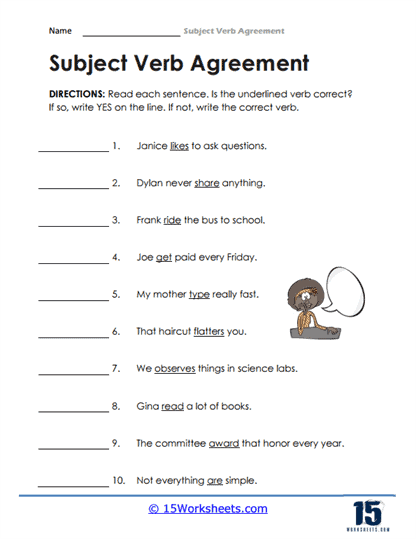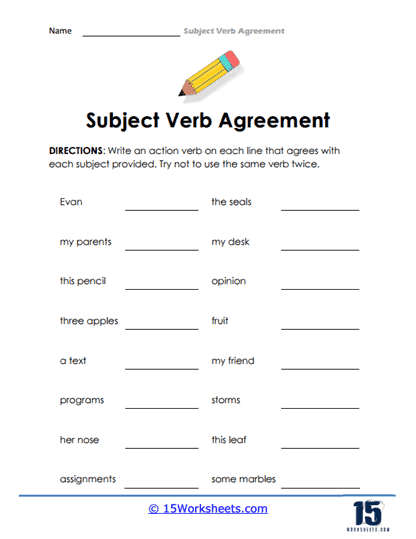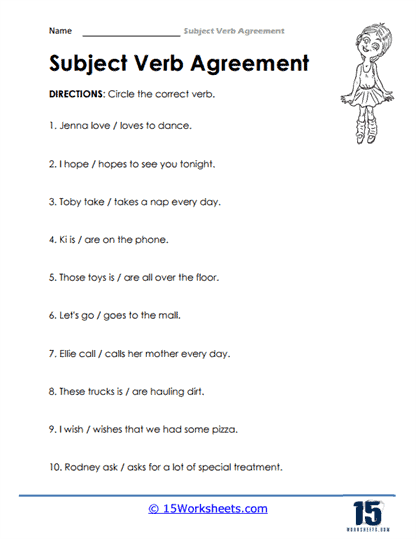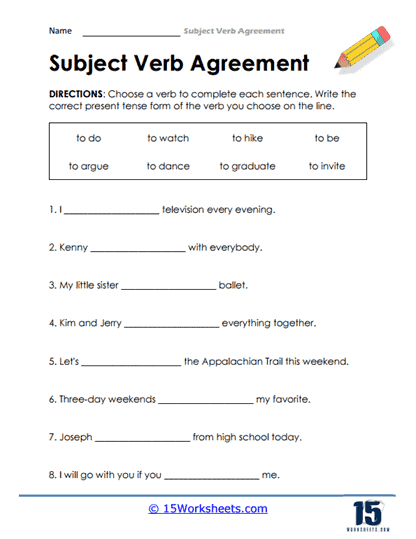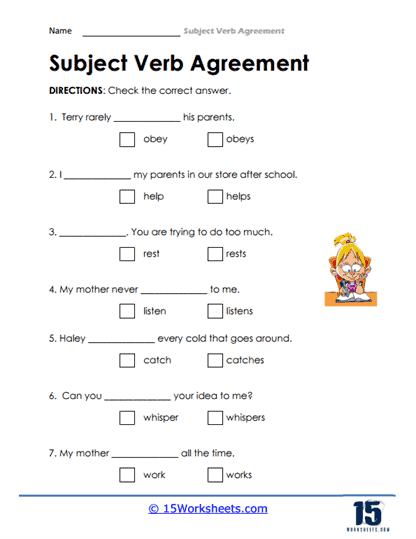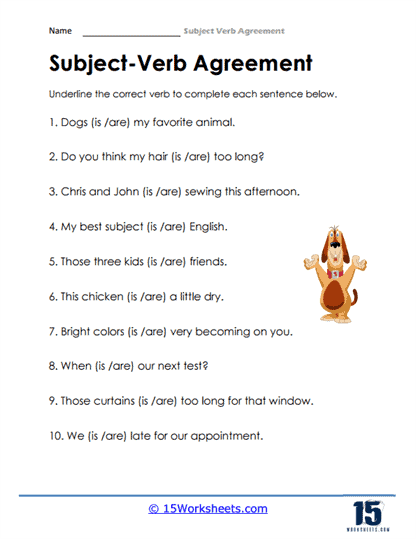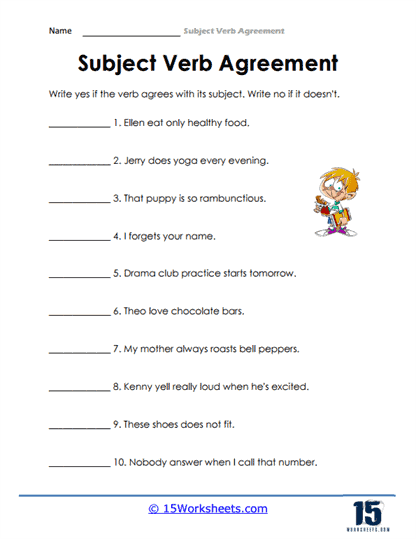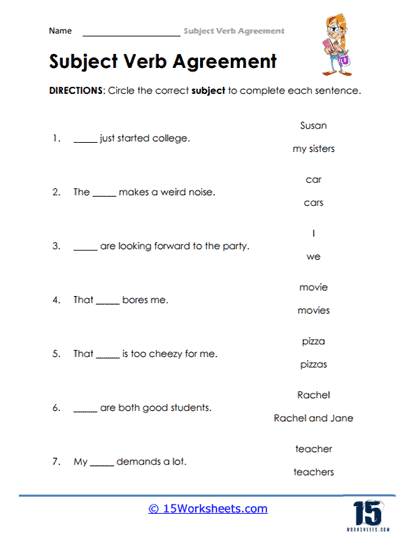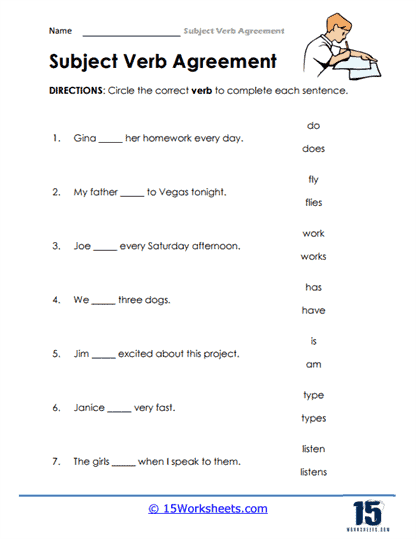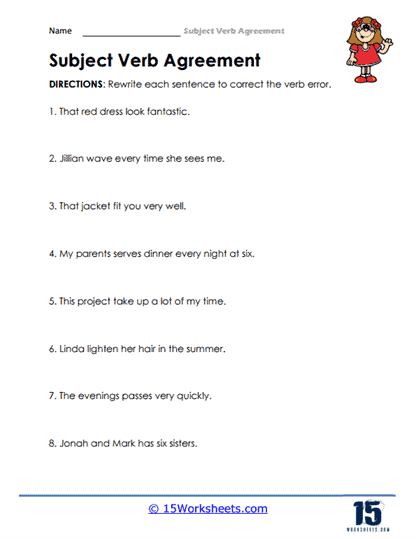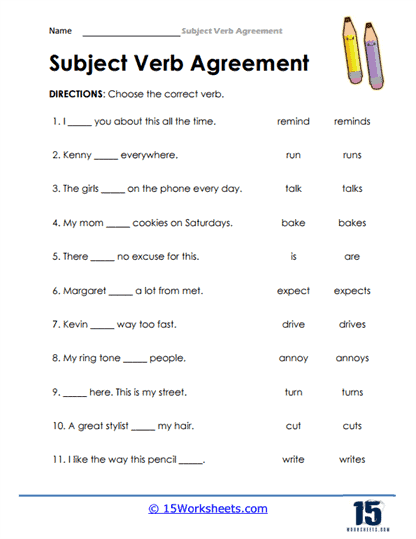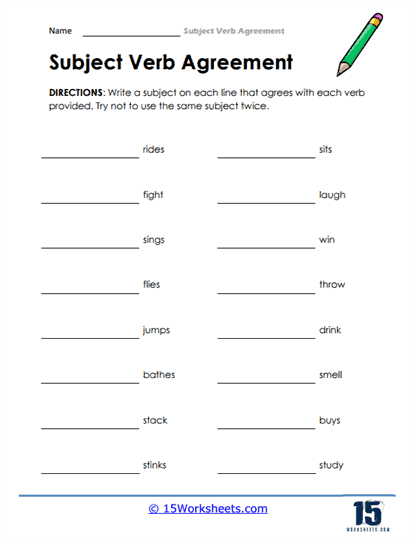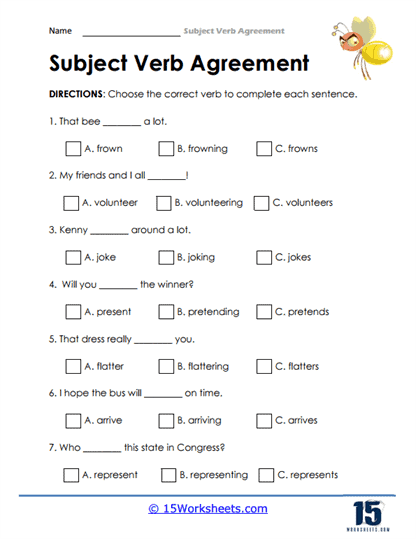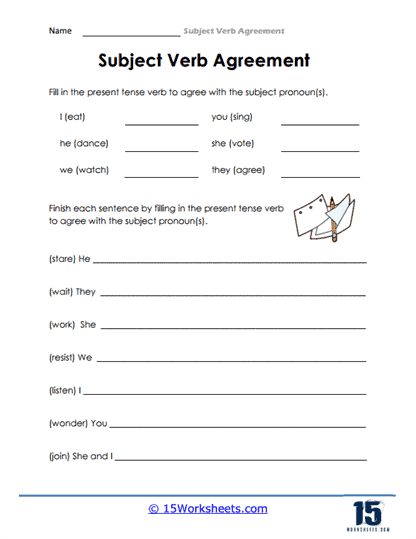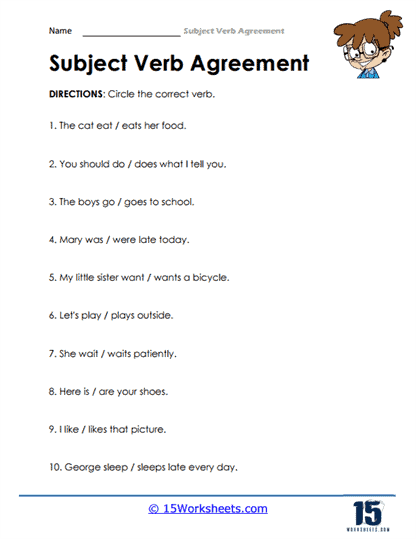Subject Verb Agreement Worksheets
All About These 15 Worksheets
Mastering subject-verb agreement is a cornerstone of effective communication in English, and this collection of subject-verb agreement worksheets is designed with that goal in mind. These resources offer students the opportunity to dive deep into one of the most fundamental aspects of grammar, providing them with the tools they need to write clearly, accurately, and with confidence. With carefully crafted exercises, students will not only learn the rules governing subject-verb agreement but will also practice applying them in a variety of contexts. These worksheets encourage a hands-on approach to learning, making complex rules easier to understand through repetition and guided practice.
At the core of these worksheets is the emphasis on identifying the subject and verb in sentences and ensuring that they agree in terms of number—whether singular or plural. Many students struggle with subject-verb agreement because of the variety of sentence structures in English, and these worksheets are designed to address that challenge head-on. Through a wide array of activities, students will get the practice they need to become adept at spotting and correcting errors in subject-verb agreement. This skill is crucial not only for academic success but also for professional and personal communication, where clarity and correctness are key.
These worksheets are not just dry drills—they are designed to engage students in meaningful, interactive learning. Fill-in-the-blank exercises require students to actively choose the correct verb form, reinforcing their understanding of the relationship between subject and verb. Rewriting activities allow students to see how changing the subject of a sentence requires an adjustment in the verb form, deepening their grasp of the concept. Additionally, short writing prompts challenge students to create their own sentences, pushing them to apply the rules of subject-verb agreement in their own writing. This variety ensures that students are not merely memorizing rules but are truly internalizing them.
By working through these exercises, students will achieve several key learning outcomes. First, they will develop the ability to assess whether the verbs in sentences agree with their subjects. This might seem straightforward, but in practice, the agreement can be obscured by phrases or clauses that intervene between the subject and verb. Students will learn to cut through this clutter and ensure grammatical consistency.
In addition, students will become adept at identifying errors in subject-verb agreement, a skill that will be invaluable as they progress in their writing. The ability to spot these mistakes is crucial not just in editing their own work but also in giving feedback to peers. Being able to correct these errors will lead to more polished, professional writing, and will help students avoid misunderstandings caused by unclear or incorrect sentence structures.
The exercises in these worksheets encourage students to produce their own sentences that demonstrate a clear and precise understanding of subject-verb agreement. This active creation is where the true test of understanding lies. Writing original sentences forces students to apply what they’ve learned, ensuring that they have not just memorized rules but can use them fluidly in their own writing. This skill is essential for all forms of communication, from academic essays to business reports to everyday emails.
What is a Subject Verb Adjective?
Conflict in any form is disliked, even inside phrases! Every sentence must contain a subject and a predicate, as we all know, but they also need to be in agreement with one another. This is referred to as subject-verb agreement in the grammar field.
Subjects and verbs most frequently differ in number and tense, respectively. In the event that the subject is plural, the verb must likewise be plural. Similarly, if the subject is multiple, the verb must be plural as well. Although it appears obvious, things can get challenging when discussing time, money, indefinite pronouns, collective nouns, and interrupting expressions.
If you were to say, “They are fun,” using the plural subject they, you would say, “They are.” Additionally, if you were to say “She is enjoyable” using the singular she, you would also use the singular is. The subjects and verbs in “She are fun” and “they is fun” don’t agree. Hence those sentences make no sense.
When a verb agrees with the portion of the subject closest to the verb, when a compound subject has both a singular, and a plural noun connected by “nor” or “or” the verb should agree with both parts of the subject. This is also known as the proximity rule. For instance, the committee members or the student both write every day.
It might be challenging to determine whether a verb should be single or plural when it is so far removed from the sentence’s subject. Appositive phrases, prepositional phrases, and direct objects are frequently misunderstood as indicating the number of the verb. It’s not like that at all! Only the subject determines whether a verb is singular or plural.
For instance: One of the many popular actors in Hollywood, Dwayne Johnson, follows a rigorous exercise routine. Although the appositive word in this sentence includes the plural noun actors, the subject in this sentence, Dwayne Johnson, is still single. Hence the verb “has” must still be singular.
Singular and Plural
Use the verb form of the subject that is closest to the verb if one subject is single and the other is plural, and the words are joined by the letters “or,” “nor,” “not only/but also,” and “neither/nor.” The lion or the bears have gotten out of the zoo. Whenever there are multiple words connected with the help of a conjunction, the verb is singular if the subjects are both singular and are related by the terms. When the conjunctions “or,” “nor,” “neither/nor,” “either/or,” or “not only/but also” link two plural subjects, the verb is plural.
Finding the appropriate subject and verb will enable you to fix subject-verb agreement mistakes. A sentence containing the prefix of comes before a topic. The key to comprehending subjects is to follow this guideline. The culprit in many, if not most, subject-verb blunders is the word of. Hasty speakers or writers may fail to catch the following all-too-common error: Yellow roses in a bouquet provide color and scent to the space.
How To Identify Subject Verb Agreement?
To grammatically identify subject-verb agreement, one must first grasp the core concept: the subject and the verb in a sentence must match in number. In other words, if the subject is singular, the verb must also be singular, and if the subject is plural, the verb must be plural. This seemingly simple rule is often complicated by the structure of sentences and the presence of additional words or clauses that may obscure the true subject of the sentence. To effectively identify subject-verb agreement, it’s essential to be able to locate the subject and the verb, determine whether the subject is singular or plural, and ensure that the verb agrees accordingly.
Step #1- Locate the Subject
The first step in identifying subject-verb agreement is to locate the subject of the sentence. The subject is the person, place, thing, or idea that the sentence is about. It is often, but not always, the noun that appears at the beginning of the sentence. Once you have identified the subject, the next step is to determine whether it is singular or plural. Singular subjects refer to one entity, while plural subjects refer to more than one. For example, in the sentence, “The cat runs across the yard,” the subject is “cat,” which is singular. Therefore, the verb “runs” is also singular, agreeing with the subject.
Step #2- Locate the Verb
The second step is identifying the verb, which describes the action or state of being of the subject. The verb must match the subject in number. In the case of a singular subject, a singular verb form is required, which often ends in “-s” in the present tense (as in “runs” or “walks”). Plural subjects, on the other hand, require verbs without the “-s” ending in the present tense (such as “run” or “walk”). Understanding this difference in verb forms is essential for ensuring agreement.
While subject-verb agreement might seem straightforward when the subject and verb are close together in a sentence, certain sentence structures can make the task more challenging. For example, prepositional phrases, clauses, or other intervening elements may come between the subject and verb, leading to confusion. These elements, however, do not affect the subject-verb relationship. To ensure proper agreement, it is important to focus only on the subject and the verb, ignoring any additional words that might complicate the sentence.
Consider the following example:
Example 1: “The bouquet of flowers is beautiful.”
In this sentence, the subject is “bouquet,” not “flowers.” The phrase “of flowers” is a prepositional phrase that modifies “bouquet,” but it does not change the number of the subject. “Bouquet” is a singular noun, so the verb “is” must also be singular to agree with the subject. This example illustrates how prepositional phrases can sometimes obscure the true subject of the sentence, but they should not distract from ensuring that the subject and verb are in agreement.
Another type of sentence structure that can complicate subject-verb agreement involves compound subjects. When two or more subjects are connected by “and,” they typically require a plural verb, as the combination of subjects creates a plural entity. However, when subjects are joined by “or” or “nor,” the verb must agree with the subject that is closest to it, which can lead to different verb forms depending on sentence structure.
Example 2: “Neither the teacher nor the students are responsible for the mistake.”
Here, we have a compound subject connected by “nor.” The verb must agree with the subject closest to it, which in this case is “students.” Since “students” is plural, the verb “are” is also plural. Had the sentence been structured differently, with “the students” appearing first, the verb would still have been plural. But if the singular subject “teacher” were closest to the verb, the sentence would read: “Neither the students nor the teacher is responsible for the mistake.”
By working through these examples, it becomes clear that identifying subject-verb agreement involves careful analysis of the sentence’s structure. Prepositional phrases and compound subjects are just two of the many elements that can complicate this process, but by focusing on the core relationship between the subject and verb, you can ensure that they agree in number. With practice, the rules of subject-verb agreement become easier to apply, leading to clearer and grammatically correct writing.

